Genome-Wide Association Study (GWAS) for Mesocotyl Elongation in Rice (Oryza sativa L.) under Multiple Culture Conditions
Abstract
1. Introduction
2. Materials and Methods
2.1. Plant Materials
2.2. Genotyping
2.3. Measurement of Mesocotyl Length
2.4. Population Structure and LD Decay Analysis
2.5. Genome-Wide Association Analysis and Candidate Genes Identification
2.6. Gene Expression Analysis
3. Results
3.1. Phenotypic Variation of Mesocotyl Elongation
3.2. Marker Coverage
3.3. Population Structure and Linkage Disequilibrium
3.4. GWAS of Mesocotyl Lengths
3.5. Candidate Genes Related with Mesocotyl Elongation
4. Discussion
4.1. Mesocotyl Elongation Varied among Culture Conditions
4.2. LD Pattern
4.3. GWAS Was Effective to Identify QTLs Controlled Complex Quantitative Traits
4.4. Potential Candidate Genes for Mesocotyl Elongation were Identified
5. Conclusions
Supplementary Materials
Author Contributions
Funding
Acknowledgments
Conflicts of Interest
References
- Kumar, V.; Ladha, J.K. Direct seeding of rice: Recent developments and future research needs. Adv. Agron. 2011, 111, 297–413. [Google Scholar]
- Kato, Y.; Katsura, K. Rice adaptation to aerobic soils: Physiological considerations and implications for agronomy. Plant Prod. Sci. 2014, 17, 1–12. [Google Scholar] [CrossRef]
- Liu, H.; Hussain, S.; Zheng, M.; Peng, S.; Huang, J.; Cui, K.; Nie, L. Dry direct-seeded rice as an alternative to transplanted-flooded rice in Central China. Agron. Sustain. Dev. 2015, 35, 285–294. [Google Scholar] [CrossRef]
- Ohno, H.; Banayo, N.P.; Bueno, C.; Kashiwagi, J.I.; Nakashima, T.; Iwama, K.; Corales, A.M.; Garcia, R.; Kato, Y. On-farm assessment of a new early-maturing drought-tolerant rice cultivar for dry direct seeding in rainfed lowlands. Field Crop. Res. 2018, 219, 222–228. [Google Scholar] [CrossRef]
- GRiSP. Rice Almanac, 4th ed.; International Rice Research Institute: Manila, Philippines, 2013; p. 283. [Google Scholar]
- Haefele, S.M.; Kato, Y.; Singh, S. Climate ready rice: Augmenting drought tolerance with best management practices. Field Crop. Res. 2013, 190, 60–69. [Google Scholar] [CrossRef]
- Kono, M. Physiological aspects of lodging. In Science of the Rice Plant, Physiology, 2; Matsuo, Y., Kumazawa, K., Ishii, R., Ishihara, K., Hirata, H., Eds.; Food and Agricultural Policy Research Center: Tokyo, Japan, 1995; pp. 971–982. [Google Scholar]
- Ramzan, M. Evaluation of various planting methods in rice-wheat cropping system, Punjab, Pakistan. Rice Crop Rep. 2003, 4, 4–5. [Google Scholar]
- Kashiwagi, T.; Sasaki, H.; Ishimaru, K. Factors responsible for decreasing sturdiness of the lower part in lodging of rice (Oryza sativa L.). Plant Prod. Sci. 2005, 8, 166–172. [Google Scholar] [CrossRef]
- Mahender, A.; Anandan, A.; Pradhan, S.K. Early seedling vigour, an imperative trait for direct-seeded rice: An overview on physio-morphological parameters and molecular markers. Planta 2015, 241, 1027–1050. [Google Scholar] [CrossRef]
- Lee, H.S.; Sasaki, K.; Kang, J.W.; Sato, T.; Song, W.Y.; Ahn, S.N. Mesocotyl elongation is essential for seedling emergence under deep-seeding condition in rice. Rice 2017, 10, 32. [Google Scholar] [CrossRef]
- Ekanayake, I.J.; Garrity, D.P.; O’Toole, J.C. Influence of Deep Root Density on Root Pulling Resistance in Rice. Crop Sci. 1986, 26, 1181–1186. [Google Scholar] [CrossRef]
- Kirby, E. Effect of sowing depth on seedling emergence, growth and development in barley and wheat. Field Crop. Res. 1993, 35, 101–111. [Google Scholar] [CrossRef]
- Turner, F.T.; Chen, C.C.; Bollich, C.N. Coleoptile and mesocotyl lengths in semi-dwarf rice seedlings. Crop Sci. 1982, 22, 43–46. [Google Scholar] [CrossRef]
- Chung, N.J. Elongation habit of mesocotyls and coleoptiles in weedy rice with high emergence ability in direct-seeding on dry paddy fields. Crop Pasture Sci. 2010, 61, 911–917. [Google Scholar] [CrossRef]
- Trachsel, S.R.; Messmer, P.; Stamp, N.R.; Hund, A. QTLs for early vigor of tropical maize. Mol. Breed. 2010, 25, 91–103. [Google Scholar] [CrossRef][Green Version]
- Wu, J.; Feng, F.; Lian, X.; Teng, X.; Wei, H.; Yu, H.; Xie, W.; Yan, M.; Fan, P.; Li, Y.; et al. Genome-wide Association Study (GWAS) of mesocotyl elongation based on re-sequencing approach in rice. BMC Plant Biol. 2015, 15, 218. [Google Scholar] [CrossRef]
- Lu, Q.; Zhang, M.; Niu, X.; Wang, C.; Xu, Q.; Feng, Y.; Wang, S.; Yuan, X.; Yu, H.; Wang, Y. Uncovering novel loci for mesocotyl elongation and shoot length in indica rice through genome-wide association mapping. Planta 2016, 243, 645–657. [Google Scholar] [CrossRef]
- Mgonja, M.; Dilday, R.; Skinner, S.; Collins, F. Association of mesocotyl elongation with seedling vigor in rice. J. Ark. Acad. Sci. 1988, 42, 52–55. [Google Scholar]
- Huang, C.; Jiang, S.K.; Feng, L.; Xu, Z.J.; Chen, W.F. QTL analysis for mesocotyl length in rice (Oryza sativa L.). Acta Agron. Sin. 2010, 36, 1108–1113. [Google Scholar]
- Huang, X.; Zhao, Y.; Li, C.; Wang, A.; Zhao, Q.; Li, W.; Guo, Y.; Deng, L.; Zhu, C.; Fan, D.; et al. Genome-wide association study of flowering time and grain yield traits in a worldwide collection of rice germplasm. Nat. Genet. 2012, 44, 32–39. [Google Scholar] [CrossRef]
- Chen, W.; Gao, Y.; Xie, W.; Gong, L.; Lu, K.; Wang, W.; Li, Y.; Liu, X.; Zhang, H.; Dong, H.; et al. Genome-wide association analyses provide genetic and biochemical insights into natural variation in rice metabolism. Nat. Genet. 2014, 46, 714–721. [Google Scholar] [CrossRef]
- Huang, X.; Sang, T.; Zhao, Q.; Feng, Q.; Zhao, Y.; Li, C.; Zhu, C.; Lu, T.; Zhang, Z.; Li, M.; et al. Genome-wide association studies of 14 agronomic traits in rice landraces. Nat. Genet. 2010, 42, 961–967. [Google Scholar] [CrossRef] [PubMed]
- Zhao, K.; Tung, C.W.; Eizenga, G.C.; Wright, M.H.; Ali, M.L.; Price, A.H.; Norton, G.J.; Islam, M.R.; Reynolds, A.; Mezey, J.; et al. Genome-wide association mapping reveals a rich genetic architecture of complex traits in Oryza sativa. Nat. Commun. 2011, 2, 467. [Google Scholar] [CrossRef] [PubMed]
- Sun, S.; Wang, T.; Wang, L.; Li, X.; Jia, Y.; Liu, C.; Huang, X.; Xie, W.; Wang, X. Natural selection of a GSK3 determines rice mesocotyl domestication by coordinating strigolactone and brassinosteroid signaling. Nat. Commun. 2018, 9, 2523. [Google Scholar] [CrossRef] [PubMed]
- Zhao, Y.; Zhao, W.; Jiang, C.; Wang, X.; Xiong, H.; Todorovska, E.G.; Yin, Z.; Chen, Y.; Wang, X.; Xie, J.; et al. Genetic architecture and candidate genes for deep-sowing tolerance in rice revealed by non-syn GWAS. Front Plant Sci. 2018, 9, 332. [Google Scholar] [CrossRef] [PubMed]
- Alexander, D.H.; Novembre, J.; Lange, K. Fast model-based estimation of ancestry in unrelated individuals. Genome Res 2009, 19, 1655–1664. [Google Scholar] [CrossRef] [PubMed]
- Radford, B.J.; Henzell, R.G. Temperature affects the mesocotyl and coleoptile length of grain sorghum genotypes. Aust. J. Agric. Res. 1990, 41, 79–87. [Google Scholar] [CrossRef]
- Feng, F.; Mei, H.; Fan, P.; Li, Y.; Xu, X.; Wei, H.; Yan, M.; Luo, L. Dynamic transcriptome and phytohormone profiling along the time of light exposure in the mesocotyl of rice seedling. Sci. Rep. 2017, 7, 11961. [Google Scholar] [CrossRef]
- Cai, H.; Morishima, H. QTL clusters reflect character associations in wild and cultivated rice. Theor. Appl. Genet. 2002, 104, 1217–1228. [Google Scholar] [CrossRef]
- Lee, S.; Kim, J.; Hong, S. Effects of priming and growth regulator treatment of seed on emergence and seedling growth of rice. Korean J. Crop Sci. 1999, 44, 134–137. [Google Scholar]
- Qiu, X.; Pang, Y.; Yuan, Z.; Xing, D.; Xu, J.; Dingkuhn, M.; Li, Z.; Ye, G. Genome-wide association study of grain appearance and milling quality in a worldwide collection of indica rice germplasm. PLoS ONE 2015, 10, e0145577. [Google Scholar] [CrossRef]
- McCouch, S.R.; Wright, M.H.; Tung, C.W.; Maron, L.G.; McNally, K.L.; Fitzgerald, M.; Singh, N.; DeClerck, G.; Agosto-Perez, F.; Korniliev, P.; et al. Open access resources for genome-wide association mapping in rice. Nat. Commun. 2016, 7, 10532. [Google Scholar] [CrossRef] [PubMed]
- Redona, E.D.; Mackill, D.J. Mapping quantitative trait loci for seedling vigor in rice using RFLPs. Theor. Appl. Genet. 1996, 92, 395–402. [Google Scholar] [CrossRef] [PubMed]
- Zhang, G.; Zeng, D.; Hu, S.; Su, Y.; Ajia, L.; Guo, L.; Qian, Q. QTL analysis of traits concerned submergence tolerance at seedling stage in rice (Oryza sativa L.). Acta Agron. Sin. 2006, 32, 1280–1286. [Google Scholar]
- Lim, J.H.; Yang, H.J.; Jung, K.H.; Yoo, S.C.; Paek, N.C. Identification of chromosomal regions influencing mesocotyl elongation by bulked segregation analysis based on genome re-sequencing in rice. Acta Agric. Shanghai 2017, 33, 10–15. [Google Scholar]
- Cao, L.; Zhu, J.; Ren, L.; Zhao, S.; Yan, Q. Mapping QTLs and epistasis for seedling vigor in rice (Oryza sativa L.). Acta Agron. Sin. 2002, 28, 809–815. [Google Scholar]
- Cao, L.; Zhu, J.; Yan, Q.; He, L.; Wei, X.; Cheng, S. Mapping QTLs with epistasis for mesocotyl length in a DH population from indica-japonica cross of rice (Oryza sativa). Chin. J. Rice Sci. 2002, 16, 221–224. [Google Scholar]
- Ouyang, Y.N.; Zhang, Q.Y.; Zhang, K.Q.; Yu, S.M.; Zhuang, J.Y.; Jin, Q.Y.; Cheng, S.H. QTL mapping and interaction analysis of genotype × environment (Fe2+-concentrations) for mesocotyl length in rice (Oryza sativa L.). Acta Genet. Sin. 2005, 32, 712–718. [Google Scholar]
- Lee, H.S.; Sasaki, K.; Higashitani, A.; Ahn, S.N.; Sato, T. Mapping and characterization of quantitative trait loci for mesocotyl elongation in rice (Oryza sativa L.). Rice 2012, 5, 1–10. [Google Scholar] [CrossRef]
- Zhang, K.; Tian, J.; Zhao, L.; Wang, S. Mapping QTLs with epistatic effects and QTL x environment interactions for plant height using a doubled haploid population in cultivated wheat. J Genet Genom. 2008, 35, 119–127. [Google Scholar] [CrossRef]
- Tetard-Jones, C.; Kertesz, M.A.; Preziosi, R.F. Identification of plant quantitative trait loci modulating a rhizobacteria-aphid indirect effect. PLoS ONE 2012, 7, e41524. [Google Scholar] [CrossRef][Green Version]
- Jan, A.; Maruyama, K.; Todaka, D.; Kidokoro, S.; Abo, M.; Yoshimura, E.; Shinozaki, K.; Nakashima, K.; Yamaguchi-Shinozaki, K. OsTZF1, a CCCH-tandem zinc finger protein, confers delayed senescence and stress tolerance in rice by regulating stress-related genes. Plant Physiol. 2013, 161, 1202–1216. [Google Scholar] [CrossRef]
- Xiong, Q.; Ma, B.; Lu, X.; Huang, Y.H.; He, S.J.; Yang, C.; Yin, C.C.; Zhao, H.; Zhou, Y.; Zhang, W.K.; et al. Ethylene-Inhibited Jasmonic Acid Biosynthesis Promotes Mesocotyl/Coleoptile Elongation of Etiolated Rice Seedlings. Plant Cell 2017, 29, 1053–1072. [Google Scholar] [CrossRef]
- Noh, B.; Lee, S.H.; Kim, H.J.; Yi, G.; Shin, E.A.; Lee, M.; Jung, K.J.; Doyle, M.R.; Amasino, R.M.; Noh, Y.S. Divergent roles of a pair of homologous Jumonji/Zinc-Finger–class transcription factor proteins in the regulation of Arabidopsis flowering time. Plant Cell 2004, 16, 2601–2613. [Google Scholar] [CrossRef] [PubMed]
- Hu, Z.; Yamauchi, T.; Yang, J.; Jikumaru, Y.; Tsuchida-Mayama, T.; Ichikawa, H.; Takamure, I.; Nagamura, Y.; Tsutsumi, N.; Yamaguchi, S.; et al. Strigolactone and cytokinin act antagonistically in regulating rice mesocotyl elongation in darkness. Plant Cell Physiol. 2014, 55, 30–41. [Google Scholar] [CrossRef] [PubMed]
- Yuldashev, R.; Avalbaev, A.; Bezrukova, M.; Vysotskaya, L.; Khripach, V.; Shakirova, F. Cytokinin oxidase is involved in the regulation of cytokinin content by 24-epibrassinolide in wheat seedlings. Plant Physiol. Biochem. 2012, 55, 1–6. [Google Scholar] [CrossRef] [PubMed]
- Zhao, Y.; Christensen, S.K.; Fankhauser, C.; Cashman, J.R.; Cohen, J.D.; Weigel, D.; Chory, J. A role for flavin monooxygenase-like enzymes in auxin biosynthesis. Science 2001, 291, 306–309. [Google Scholar] [CrossRef] [PubMed]
- Wan, X.R.; Li, L. Regulation of ABA level and water-stress tolerance of Arabidopsis by ectopic expression of a peanut 9-cis-epoxycarotenoid dioxygenase gene. Biochem. Biophys. Res. Commun. 2006, 347, 1030–1038. [Google Scholar] [CrossRef]
- Thompson, A.J.; Jackson, A.C.; Symonds, R.C.; Mulholland, B.J.; Dadswell, A.R.; Blake, P.S.; Burbidge, A.; Taylor, I.B. Ectopic expression of a tomato 9-cis-epoxycarotenoid dioxygenase gene causes over-production of abscisic acid. Plant J. 2000, 23, 363–374. [Google Scholar] [CrossRef]
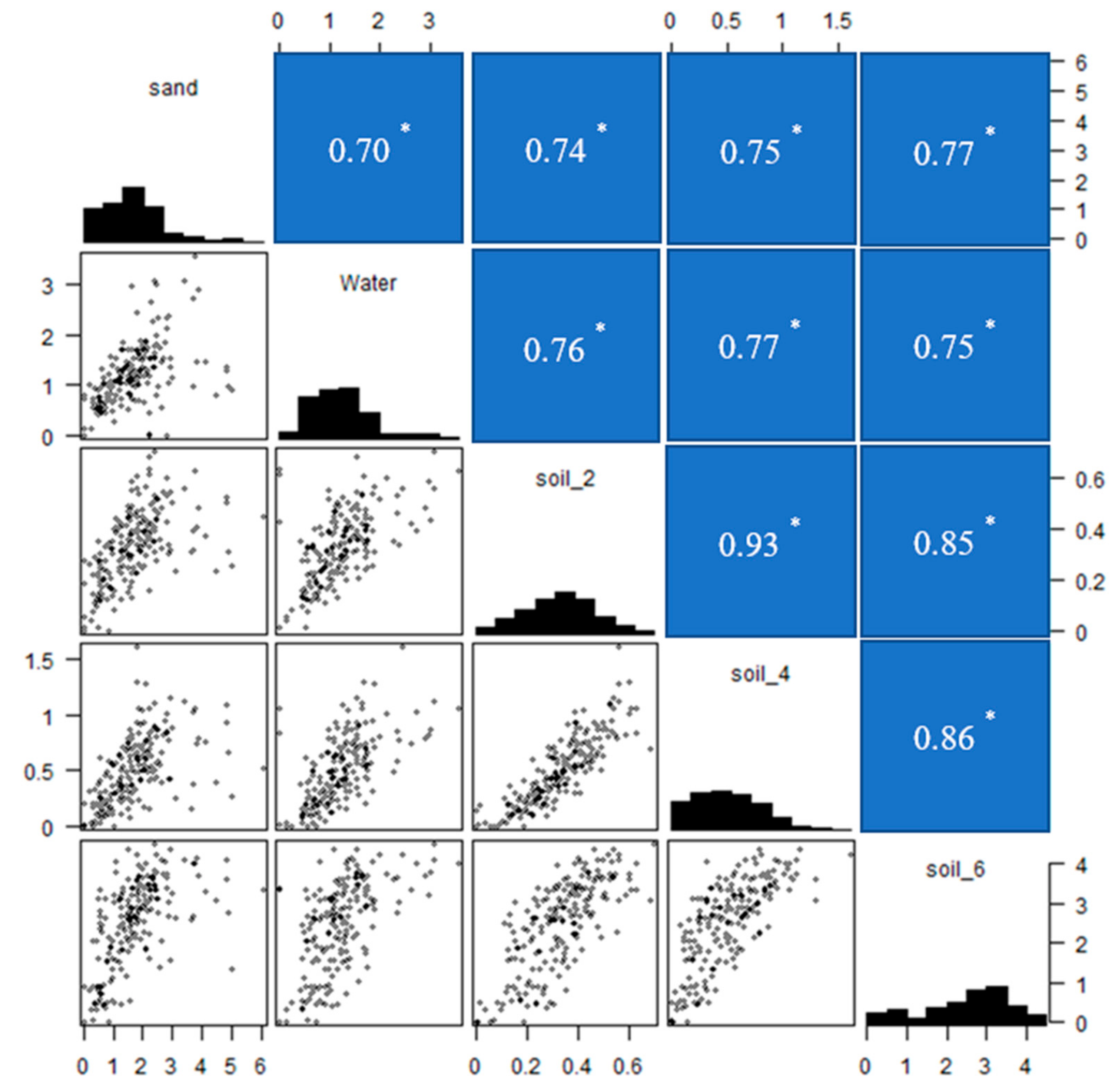
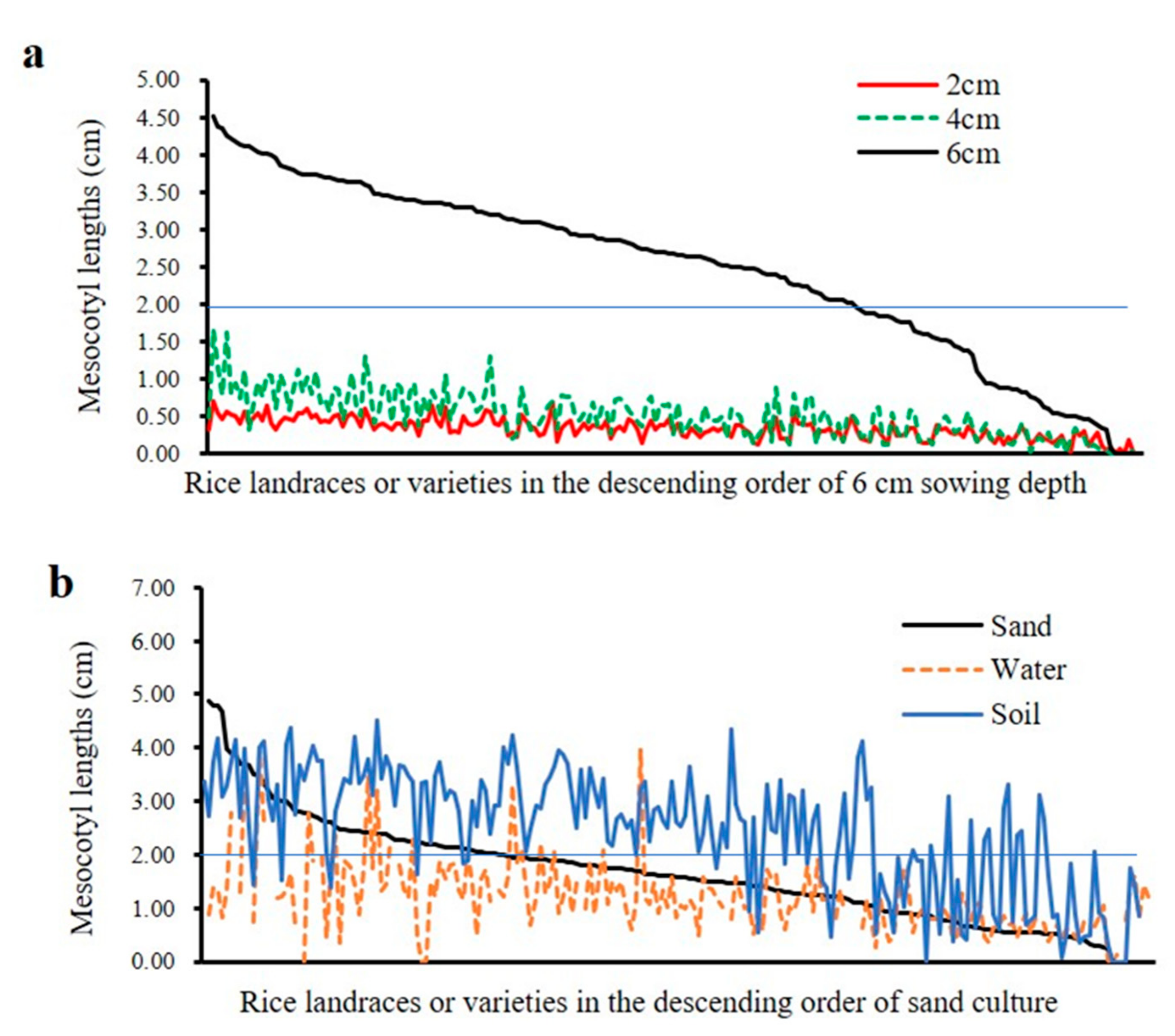
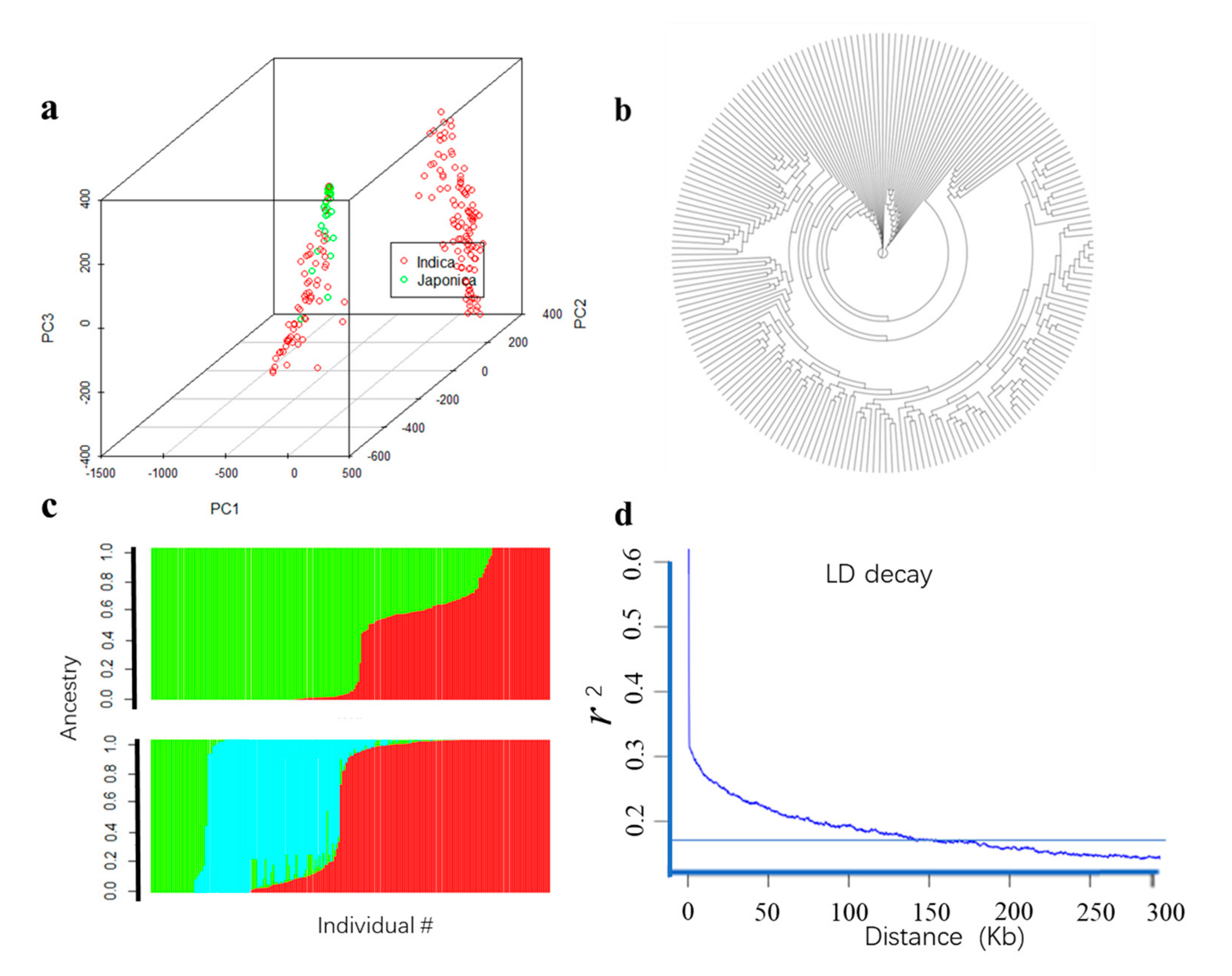
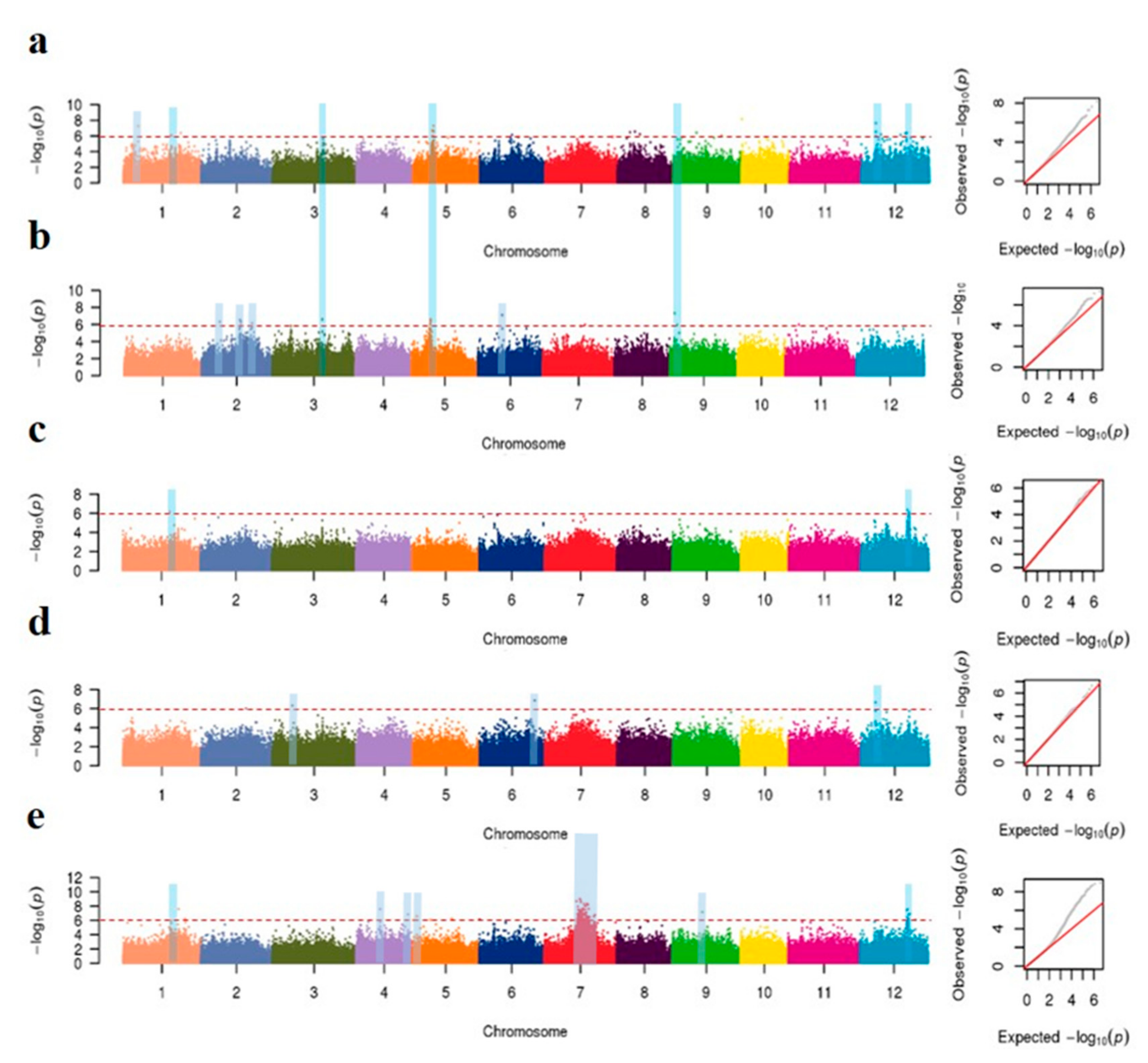
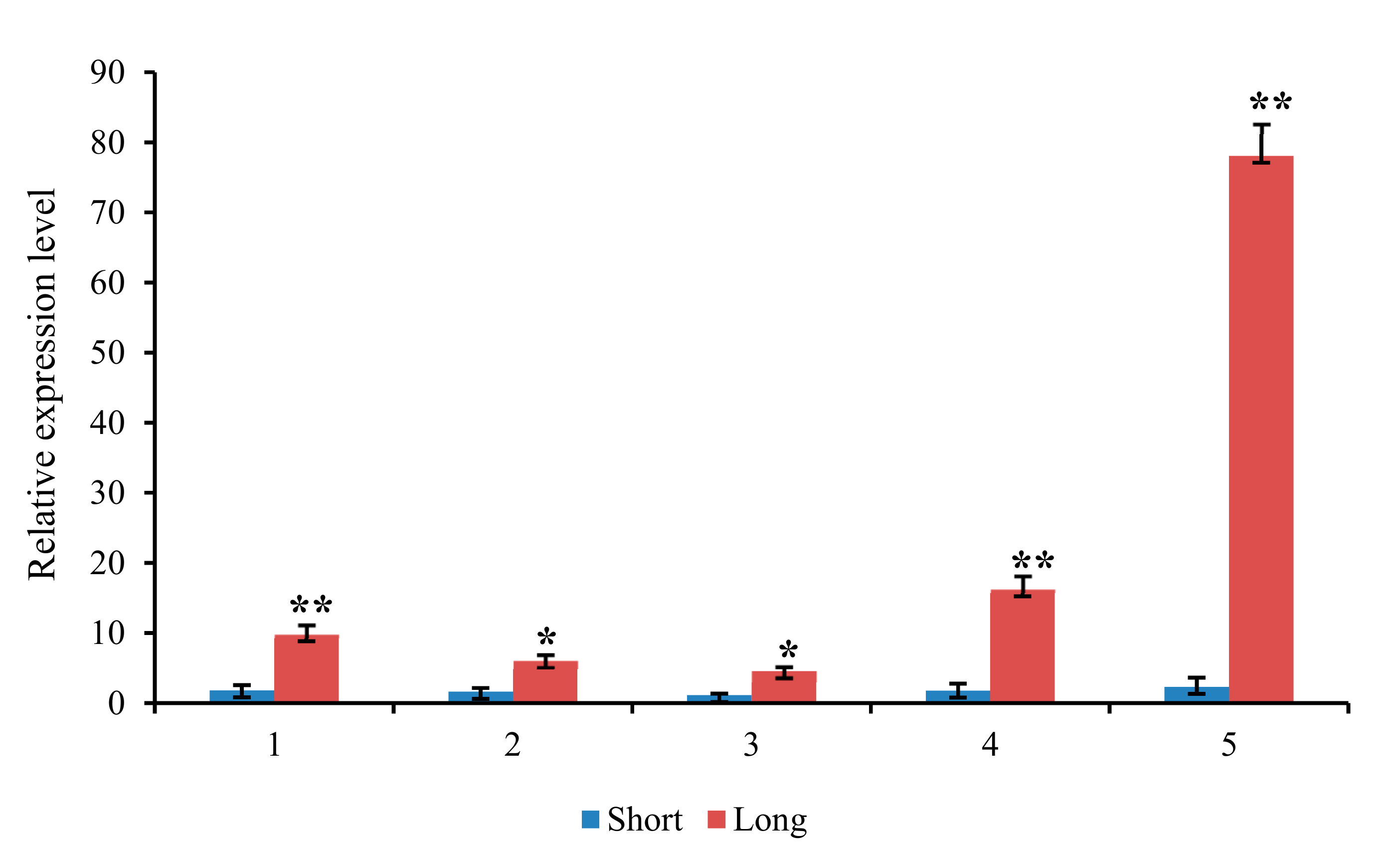
| Source | df | Sum of Square | Mean Square | F-Value |
|---|---|---|---|---|
| Block (Environment) | 5 | 0.9063 | 0.1813 | 2.5698 *** |
| Genotype | 207 | 583.1571 | 2.8172 | 39.9407 *** |
| Environment | 4 | 1270.5662 | 317.6415 | 4503.3657 *** |
| Genotyped × Environment | 813 | 533.9877 | 0.6568 | 9.3120 *** |
| Peak Marker | Chr. | Genomic Regions (Mb) | P Value | R2 (%) | Environment | Reported Locus | References |
|---|---|---|---|---|---|---|---|
| rs_1_16752644 | 1 | 14.1~17.3 | 1.9 E-08~7.7 E-07 | 7.2–15.2 | Sand, Soil (2 cm), Soil (6 cm) | qml1-1 and qML1 | Cao et al. 2002a, Huang et al., 2010 |
| rs_2_5647116 | 2 | 5.6-8.7 | 4.8~9.4 E-07 | 7.6–8.1 | Water, Sand | qML2 | Huang et al., 2010 |
| rs_2_11740641 | 2 | 11.7-15.4 | 2.8-7.3 E-07 | 8.1–15.5 | Water, Soil (4 cm) | ||
| rs_3_15245138 | 3 | 15.2-15.3 | 2.5-5.7 E-07 | 14.8–14.9 | Water, Sand | qml3-1 | Ouyang et al., 2005 |
| rs_4_7234284 | 4 | 7.2 | 8.2 E-08 | 14.9 | Soil (6 cm) | Qml4-1 | Ouyang et al., 2005 |
| rs_5_6206136 | 5 | 5.8-6.3 | 9.5E-09~9.7E-07 | 6.6–15.3 | Water, Sand | Qml5-5 | Ouyang et al. 2005 |
| rs_5_11950679 | 5 | 10.6-12.0 | 6.6~7.6E-07 | 6.6–8.1 | Sand, Soil (6 cm) | ||
| rs_6_7313005 | 6 | 7.3-9.7 | 7.7E-08~8.4E-07 | 7.1–8.1 | Water, Sand | qML6 | Huang et al., 2010 |
| rs_6_16643928 | 6 | 15.3-16.6 | 1.2~3.7 E-07 | 6.7–14.4 | Sand, Soil (4 cm) | ||
| rs_7_10769188 | 7 | 10.0-13.6 | 2.8E-09~9.9E-07 | 6.4–15.9 | Soil (6 cm) | qFML7-1 | Zhao et al., 2018 |
| rs_8_5219449 | 8 | 2.8-5.2 | 6.8E-08~3.5E-07 | 14.6–15.3 | Sand | qLOE-8 | Zhang et al., 2006 |
| rs_9_1446824 | 9 | 1.3-2.8 | 4.8E-08~4.8E-07 | 14.9–15.2 | Water, Sand | seq-rs4080 | Lu et al., 2016 |
| rs_9_7059246 | 9 | 7.1-9.1 | 8.5 E-08~1.2 E-07 | 14.7–14.8 | Sand, Soil (6 cm) | ||
| rs_12_4444693 | 12 | 4.4-4.5 | 4.3E-09~5.9E-07 | 14.8–15.7 | Sand, Soil (4 cm), Soil (6 cm) | ||
| rs_12_6008455 | 12 | 6.0-7.8 | 1.2~4.6 E-07 | 14.7–15.4 | Sand | ||
| rs_12_14155486 | 12 | 13.3-15.0 | 2.3E-08~9.9E-07 | 7.5–15.3 | Sand, Soil (2 cm), Soil (6 cm) | qMel-12 | Lee et al. 2012b |
| Chromosome | Genomic Regions | Candidate Gene | Functional Annotation |
|---|---|---|---|
| 5 | 5688534-6067598 | LOC_Os05g10670 | Zinc finger CCCH type family protein, putative, expressed |
| 5 | 5688534-6067598 | LOC_Os05g10770 | Transcription factor jumonji, putative, expressed |
| 9 | 1245230-1521824 | LOC_Os09g03140 | Cytokinin-O-glucosyltransferase 2, putative, expressed |
| 12 | 4369693-4551492 | LOC_Os12g08780 | Flavin monooxygenase, putative, expressed |
| 12 | 14080486-14520450 | LOC_Os12g24800 | 9-cis-epoxycarotenoid dioxygenase 1, chloroplast precursor, putative, expressed |
© 2019 by the authors. Licensee MDPI, Basel, Switzerland. This article is an open access article distributed under the terms and conditions of the Creative Commons Attribution (CC BY) license (http://creativecommons.org/licenses/by/4.0/).
Share and Cite
Liu, H.; Zhan, J.; Li, J.; Lu, X.; Liu, J.; Wang, Y.; Zhao, Q.; Ye, G. Genome-Wide Association Study (GWAS) for Mesocotyl Elongation in Rice (Oryza sativa L.) under Multiple Culture Conditions. Genes 2020, 11, 49. https://doi.org/10.3390/genes11010049
Liu H, Zhan J, Li J, Lu X, Liu J, Wang Y, Zhao Q, Ye G. Genome-Wide Association Study (GWAS) for Mesocotyl Elongation in Rice (Oryza sativa L.) under Multiple Culture Conditions. Genes. 2020; 11(1):49. https://doi.org/10.3390/genes11010049
Chicago/Turabian StyleLiu, Hongyan, Junhui Zhan, Jiaolong Li, Xiang Lu, Jindong Liu, Yamei Wang, Quanzhi Zhao, and Guoyou Ye. 2020. "Genome-Wide Association Study (GWAS) for Mesocotyl Elongation in Rice (Oryza sativa L.) under Multiple Culture Conditions" Genes 11, no. 1: 49. https://doi.org/10.3390/genes11010049
APA StyleLiu, H., Zhan, J., Li, J., Lu, X., Liu, J., Wang, Y., Zhao, Q., & Ye, G. (2020). Genome-Wide Association Study (GWAS) for Mesocotyl Elongation in Rice (Oryza sativa L.) under Multiple Culture Conditions. Genes, 11(1), 49. https://doi.org/10.3390/genes11010049






